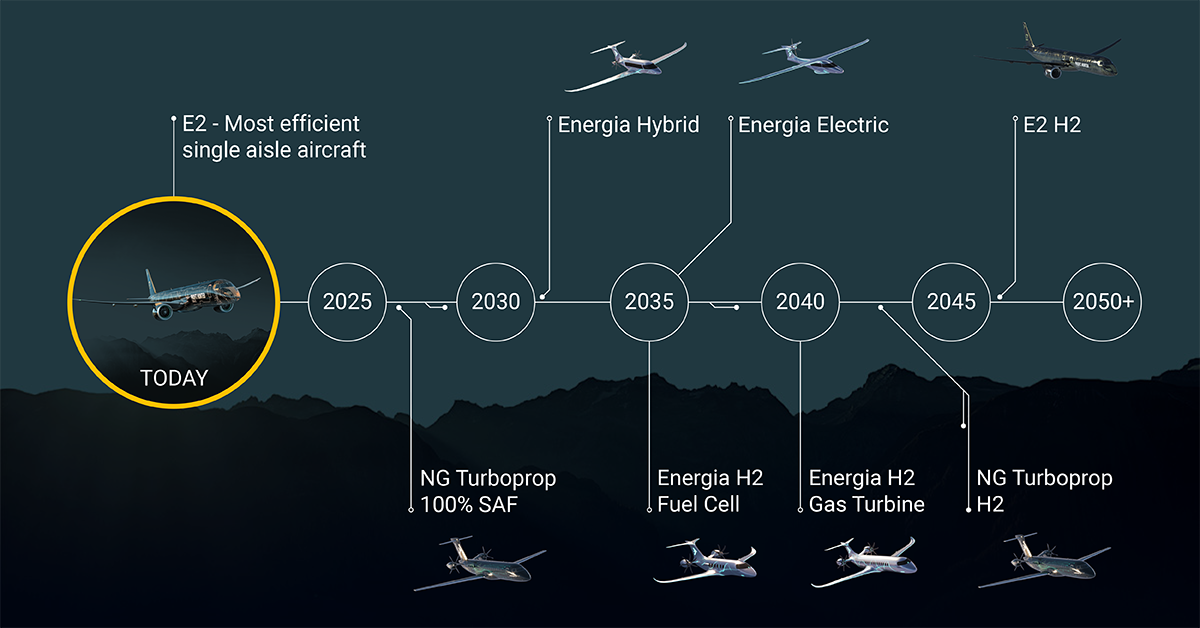Sustainability. Embraer Is Taking Action

The aviation industry is coming under increasing pressure from governments, regulatory organizations and the general public to reduce emissions. To address this, the industry has come together and pledged to cut net carbon emissions to zero by 2050. If this is to be achieved within the time scale, both manufacturers and airlines will need to employ radical new thinking and look to ‘bold and viable’ solutions. Embraer is leading the way with its sustainability roadmap and concepts development plan, announced at the end of 2021.
Committed to a sustainable future
Embraer’s roadmap encompasses the development of products, services and sustainable technologies. As Embraer President and CEO, Francisco Gomes Neto said recently “ At Embraer, we recognise the urgency of the climate crisis and we are fully committed to a sustainable future. We are stepping up our efforts to minimise our carbon footprint by remaining dedicated to innovating solutions that have a broader impact for our customers, our local communities and our aircraft.” At this year’s Singapore Airshow, Arjan Meijer, President and CEO, Embraer Commercial Aviation sees innovation and new technologies playing an ever greater part in the drive towards more sustainable operations “Smaller aircraft are going to be the first platforms on which new propulsion systems will be introduced. It is because we can apply those systems more easily on a small scale, like the regional aircraft, and gradually put the technology on bigger and bigger airplanes.”
How will this roadmap evolve?
The success of Embraer’s roadmap will be dependent on technological readiness to achieve key milestones. Today, Embraer’s newly-designed E2 is the most fuel efficient single–aisle aircraft in commercial service, reducing emissions by over 30% compared to the previous generation aircraft. Looking forward to 2025, Embraer is planning the first flight of their hydrogen-powered electric demonstrator and then in 2026, eVTOL, its fully electric, zero-emissions vertical takeoff and landing vehicle could be flying passengers around cities, transforming urban mobility. Between 2027 and 2030, Embraer aim to have their E2 and game-changing new turboprop flying on regional routes, 100% SAF compatible. With the company’s strong track record in successful turboprop development, this aircraft is destined to revolutionize the segment, cutting CO2 emissions by up to 15% compared to other aircraft in the sector. It will also be the first commercial aircraft in the world designed to run on 100% SAF from the operation start.
Energia family announced
At a special event in Brazil last November, Embraer announced four new regional concepts – the Energia family. With brand new propulsion architectures that use renewable energies, each of these concept aircraft will go through a rigorous study, testing and evaluation phase and if everything goes to plan the first production aircraft could enter commercial service as early as the mid-2030s. In the next decade, around 2045, we may see the first flight of Embraer’s hydrogen-powered turboprop and finally, in 2050, Embraer’s aim is to have a hydrogen-powered E2 or similar sized aircraft taking to the skies.
50 years’ of market experience
Undoubtedly, these are bold and ambitious steps, but with over 50 years of experience in the regional market, manufacturing efficiencies along with an extremely competitive cost structure, Embraer is ideally positioned to bring disruptive technologies to smaller aircraft platforms. The company is also fostering new partnerships and working closely with leading universities and academic institutions to overcome the challenges of energy harvesting, storage and thermal management, as well as exploring new ways to make commercial operations more efficient with their global customers and governments. The next two decades will be an exciting time for regional aviation and if the industry is to become truly sustainable, as Embraer is demonstrating, actions speak louder than words!




